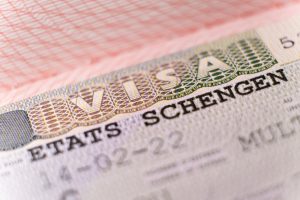Can you imagine a world where you need to show your passport to move between Luxembourg and its neighbours? A world where your online order from a business in France requires you to pay import duties? A world where overseas travellers need multiple visas to complete their Eurotrip? This is a world without Schengen.
The Schengen agreement celebrates 40 years in 2025. On 14 June 1985, heads of State from France, Germany, Luxembourg, Belgium and the Netherlands boarded the riverboat “MS Princesse Marie Astrid” on the Moselle River in the small town of Schengen along Luxembourg’s picturesque waistrooss (wine route) to sign an agreement which would eventually become an important pillar of the modern European Union. The agreement paved the way for borderless travel for people and goods within the Schengen area, which extends today to 29 countries, including most countries of the European Union (with the exception of Ireland and Cyprus) as well as Iceland, Norway, Lichtenstein and Switzerland.
Three law professors and members of the Jean Monnet Centre of Excellence Robert Schuman Initiative for European Affairs (RSI) at the University of Luxembourg took the time to reflect on the evolution of the Schengen agreement over its forty years, as well as present-day challenges to the ideals it embodies.
A tool to strengthen trust and cooperation
Professor Eleftheria Neframi, who specialises in European Union Law with research interests in institutional and procedural European law and the EU external relations, acknowledges how the Schengen area, which now includes countries that are not part of the European Union, is focused mainly on freedom and security, and not economic considerations. Prof Neframi touches upon the necessity, over time, for the development of common policies among the members to deal with controls at external borders.
As an example, Prof. Neframi cites the Schengen information system, a well-developed system of administrative cooperation to secure external borders which has had the positive effect of also encouraging strategic alignments between member states in the field of administrative law. The common visa policy, as well as the migration and asylum policy are also striking examples of harmonised rules stemming from political and geographical realities of the Schengen Area.
Prof. Luca Ratti, Associate Professor of European and Comparative law highlights how the Schengen Area, as an enabler for the free movement of people, has created communities of crossborder workers. This has been especially important for the economic growth of Luxembourg, with almost half of its workforce (47% – STATEC 2024) comprising non-resident workers.
Protecting the spirit of Schengen
Prof. Neframi reminds us that Schengen does not mean the absolute abolition of internal border controls without taking the interests of the Member States and their reserved competence in the field of security and public order into account. However, the reintroduction of border controls is an exceptional derogating measure. Prof. Neframi acknowledges that defining the limits of the Member States’ discretion and deciding how to enforce these limits remains challenging. The national courts have a role to play in assessing the compatibility of national measures with EU law obligations, says Prof. Neframi, putting forth the suggestion of horizontal cooperation between national judges. Furthermore, exceptional national measures must not be used as grounds for derogating from the protection of fundamental rights.
Prof. Katerina Pantazatou, Associate Professor in Tax Law and Director of the RSI warns against use and abuse of the provisions for reintroduction of border controls by individual States. With more and more countries citing national security as a reason to reintroduce controls, Prof. Pantazatou emphasizes that there are more suitable legal instruments available for this purpose. Normalising exceptional or extraordinary circumstances in order to apply internal border controls undermines the very essence of the Schengen agreement, says Prof. Pantazatou. To her mind, the values of trust and cooperation on which the agreement is built are too important to throw away under the pretext of national security.
All professors acknowledge the challenges and tests that the Schengen area has faced in the past 40 years. Prof. Ratti uses the COVID-19 crisis as an example of a test to the rights of workers in the Schengen area. Citing the Court of Justice of the EU Grand Chamber decision of 5 December 2023, Prof. Ratti explains that the ban on non-essential travel outside of Belgium was upheld, therefore setting a legal precedent for the restriction of freedom of movement in extraordinary circumstances. In this context, Prof. Pantazatou cautions against a backslide, stating that instead of imposing more controls, we should be reinforcing free movement, cooperation and trust among the Schengen States.
The future of the Schengen area
The Schengen area is in constant evolution. Members join, and in the post-Brexit case of the Republic of Ireland, members leave. After 40 years, we’ve seen how borderless travel creates communities, develops economies and changes demography; we have also witnessed tests to the resilience of Schengen in the form of mass migration and global pandemic. What will the Schengen area look like in the next 40 years? It will certainly depend on the balance we strike now between the interests of countries and the interests of the Schengen area as a whole.
